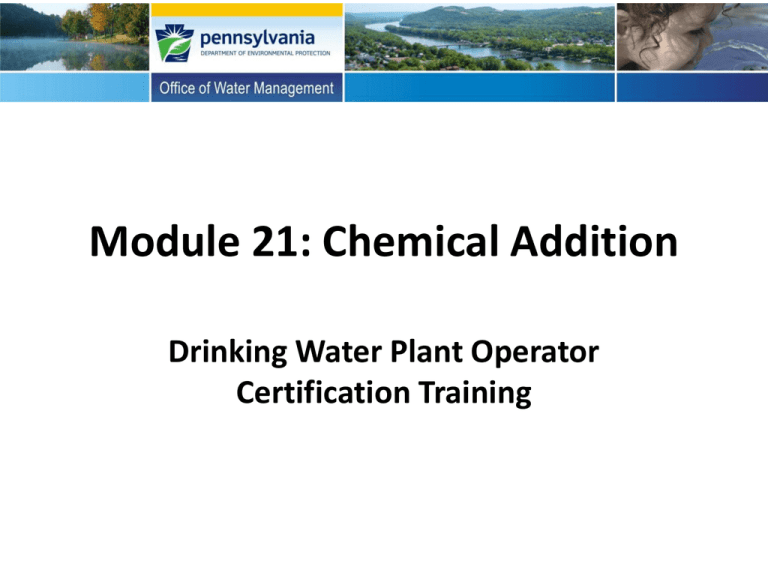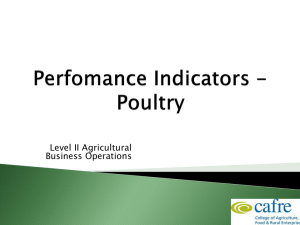Powerpoint Chemical Addition Feb 2014
advertisement

Module 21: Chemical Addition Drinking Water Plant Operator Certification Training Chemical Addition Topics Unit 1 – Chemicals Used in Water Treatment Unit 2 – Safety and Handling Unit 3 – Chemical Dosage Calculations Unit 4 – Chemical Feed Systems 2 Unit 1 – Chemicals Used in Water Treatment Learning Objective – When given a source water problem, participants will be able to identify on the Chemical Usage Table those chemicals used to address and correct the problem in the treatment of drinking water. 3 Chemical Uses Coagulation Chemicals pH Adjustment Taste and odor control Trace elements and Heavy Metals Corrosion Control and Sequestering Fluoridation Disinfection 4 Coagulating Chemicals The addition of coagulant chemicals promotes the destabilization of the smaller, nonsettleable particles and colloidal particles resulting in the aggregation of these particles into larger, more settleable floc. Types of coagulating chemicals? Ferric Chloride Aluminum Chloride 5 Types of Coagulant Chemicals Coagulants Primary Coagulants Coagulant Aids 6 Common primary coagulant chemicals and their corresponding Common Primary Coagulant Chemicals pHs Type Chemical pH 3.3-3.6 Aluminum Salts Dry Alum (Aluminum Sulfate) Liquid Alum (Aluminum Sulfate) Poly Aluminum Chloride Ferric Chloride 1.8 less than 2 Ferric Sulfate 1 Iron Salts 7 2.1 pH 8 If you add The pH will be: KOH Raised HNO3 Lowered Calcium Hydroxide Hydrated Lime Ca(OH)2 Raised Calcium Hydroxide Slaked Lime Ca(OH)3 Raised Sulfuric Acid H2SO4 Lowered Sodium Hydroxide AKA: Caustic Soda NaOH Raised Potassium hydroxide Nitric Acid 9 Soda Ash Na CO Raised Practically every phase of water treatment is pH dependent. Coagulation Efficiency Iron and Manganese Removal pH Disinfection Efficiency Corrosion Control Treatment Disinfection By-product Creation 10 Alkalinity • Alkalinity is a measure of the capacity of water or any solution to neutralize or “buffer” acids. This measure of acid-neutralizing capacity is important in figuring out how “buffered” the water is against sudden changes in pH. Alkalinity should not be confused with pH. 11 Chemical Impacts on Alkalinity •1 part alum uses 0.5 parts alkalinity for proper coagulation •1 part ferric chloride will consume 0.92 parts alkalinity for proper coagulation •Sodium bicarbonate (Bicarbonate Soda) will make water more alkaline. It can be used when you only want to increase the alkalinity. •pH adjustment chemicals may also increase alkalinity. Therefore, alkalinity may be 12 increase by the addition of lime, caustic soda Taste and Odor •Taste and odor in drinking water are among the most common and difficult problems that confront waterworks operators. •Various chemicals are added to remove tastes and odors. There are two general methods for controlling tastes and odors. • Removal of the causes of the tastes and odors 13 • Destruction of taste and odor causing Removal of Trace Elements and Heavy Metals • In small quantities, certain heavy metals are nutritionally essential for a healthy life, but large amounts of any of them may cause acute or chronic toxicity (poisoning). •There are three processes by which these removals are accomplished: • Oxidation • Improved 14 Corrosion Control and Sequestration • Corrosive water is characterized by pH and alkalinity values that are somewhat lower than they should be for the water to be considered “stable”. •Chemical Treatment of Corrosive Water: –Stabilizing the water. –The use of corrosion inhibitors. 15 Fluoridation •Fluoride is added to the drinking water to improve the development of teeth and bones in young children! •Most commonly added fluoridation chemicals: • sodium fluoride • sodium silicofluoride • hydrofluosilicic acid 16 •Please note: any fluoride chemical is nasty. Please wear the Disinfection •Disinfection kills or inactivates diseasecausing organisms in a water supply. •There are two kinds of disinfection: • • Primary disinfection achieves the desired level of microorganism kill or inactivation. • Secondary disinfection maintains a disinfectant residual in the finished water that prevents the regrowth of 17 microorganisms. Chemical Usage Table •Key Information on various chemicals for your reference 18 Unit 1 Exercise 1. 2. 3. 4. 5. 6. 7. 8. Coagulation Coagulant aids pH Alkalinity Calcium and Magnesium Sequestering agents Primary disinfection Secondary disinfection 19 Question 9 The pH will be raised or lowered 1.NaOH Raised 1.Aluminum Sulfate Lowered 1.Ca (OH)2 Raised 1.Sulfuric Acid Lowered 1.H2SiF6 Lowered 1.Ferric Chloride Lowered 1.Na2CO3 Raised If you add: 20 Unit Quiz Questions 10/11 • 2.might Nameadd several • 1. List the chemicals you to control chemicals which might be odor. Include the chemical name and best feeding form for each. added during the coagulation process. • • • • • • Activated Carbon - Dry to form slurry Ozone – Gas • Aluminum Sulfate - Coagulant Pot Permanganate - Dry to form solution • Ferric Chloride - Coagulant Sodium Chlorite - Dry or solution • Ferric Sulfate - Coagulant Chlorine – Gas • Poly Aluminum Chloride -Coagulant Sodium Hypochlorite – Solution • Calcium Hydroxide-pH Adjustment • Calcium Oxide pH Adjustment 21 • Sodium Bicarbonate - pH Adjustment Unit 2 Key Points Page 1-16 in the workbook 22 Unit 2 – Safety and Handling •Learning Objectives – When given a Material Safety Data Sheet and specific chemical names, identify specific information related to chemical characteristics and other information provided . – List the five components of Chemical Handling Equipment. 23 Parts of the SDS • 16 required sections • Now available electronically (pull it up on your phone!) 24 Five Components of Chemical Handling Equipment 1. 2. 3. 4. 5. Selection of Equipment – follow the SDS Labels and Warning Signs Breathing Protection Protective Clothing Protective Equipment. 25 Emergency Response Planning • An emergency response plan (ERP) must be developed to help a system protect public health, limit damage to the system and the surrounding area, and help a system return to normal as soon as possible. Employees who are prepared know what actions must be taken in the event of an emergency. •A good ERP includes: •Contact information •Assessment of Available26Resources Unit 2 Key Points The single most important resource for finding information about a chemical is the Material Safety Data Sheet (MSDS). • When using chemicals, protections are necessary. These protections include labels, signs, and safe chemical handling equipment. Not all chemicals require the same protections. A good Emergency Response Plan contains contact information, an assessment27 of available Unit 3 – Chemical Dosage Calculations •Learning Objective – When given the formula and required data, calculate chemical dosages for each of the following: Dry Chemicals, Liquid Chemicals, and Gaseous Chemicals . 28 Feed Systems • Feed system need to deliver chemicals into the treatment system at rates necessary for optimal performance. When designing a chemical feed system consider: Building redundancy into the system so if there is a failure or malfunction in the primary system, a secondary system can be used. Checking the feed pump dosage range. Feed pumps should be sized so that chemical dosages can be changed to meet varying conditions. Evaluating the condition of the chemical feed system 29 regularly. Preventative maintenance is critical for Flow • Chemical Feed System 1. Chemical Storage 2. Suction Assembly 1. Foot Valve 2. Suction Strainer 3. Calibration Chamber 4. Four-Function Valve 1. Anti-Siphon Valve 2. Back Pressure Relief Valve 3. Pressure Relief Valve 4. Priming Function 5. Pulsation Dampener 6. Injector Assembly 7. Liquid Feed Pump 30 Mechanical Diaphragm Metering Pump •Pump pulling chemical from the storage container: Valve Closed Discharge Check Valve (Outlet) Plunger moves left Diaphragm Suction Check Valve (Inlet) Valve Open 31 Mechanical Diaphragm Metering Pump •Chemical is pushed in to the system. Discharge Check Valve (Outlet) Valve Open Plunger moves right Diaphragm Valve Closed 32 Suction Check Valve (Inlet) Adjusting Chemical Feed Pump Dosage • The output of the pump is controlled by the length of the plunger stroke and the number of repetitions of the stroke (the speed and the stroke). Pumps may be controlled manually or by a rate of flow meter (flow pacing). 33 Liquid Chemical Feed System Operation and Maintenance Observe all operating components daily. Maintain a regular schedule of maintenance on all equipment as per the manufacturer’s recommendations Chemical metering pumps should be calibrated on a regular basis or when the operator suspects a problem with the pump (pump calibration demonstration to follow). Any leak throughout the system will cause a reduction in the amount of chemical solution pumped. All leaks must be repaired as soon as they are discovered. – If the pump looks to be operating, but the chemical feed is less than expected, suspect a ruptured diaphragm. The suction assembly on a chemical metering pump should be inspected 34 and cleaned on a regular basis as per the manufacturer’s Dry Chemical Feed Systems •Used to feed chemicals like: • • • • Lime Fluoride Carbon Potassium permanganate A dry feeder measures dry chemical and mixes it with water in a solution tank. The resulting solution is either pumped into the main water flow of the system or fed in using an ejector. An ejector system uses the Venturi effect to create a vacuum and moves the solution into the main 35 water flow. Volumetric Dry Feeders • Chemical is usually stored in a silo above the unit and each time the system needs to make a new batch of solution a feed mechanism (rolls or screws) to deliver exactly the same volume of dry chemical to the dissolving tank with each complete revolution. 36 Gravimetric Dry Feeders • This is a belt-type feeder that delivers a certain weight of material with each revolution of the conveyor belt. 37 Dry Chemical Feed System Operation and Maintenance 1. Observe operating components daily. 2. Follow manufacturer’s recommendations when performing maintenance. 3. These units are feeding fine powdery chemicals therefore cleaning and inspection of all moving parts should be conducted routinely. 4. After all preventative maintenance has been completed, proper calibration should 38 be completed. Detention Time •Detention time indicates the amount of time a give flow of water is retained by a unit process. It is calculated as the tank volume divided by the flow rate: • •Detention Time Equation • Time units match = minutes •Theoretical Detention Time (minutes) = Volume of Tank Volume units (gallons) match = gallons Influent Flow39(gpm) There are two basic ways to consider detention time: Detention time is the length of time required for a given flow rate to pass through a tank. • Detention time may also be considered as Flowlength of time required to fill a tank at a the given flow rate. Flow Flow 40 Example 3.1 – Detention Time Calculation •A sedimentation tank holds 50,000 gallons and the flow into the plant is 500 gpm. What is the detention time in minutes? • •Detention Time (time) = Volume = 50,000 gallons • Flow 500 gpm • minutes 41 = 100 Example 3.2 – Detention Time Calculation •A tank is 20 feet by 35 feet by 10 feet. It receives a flow of 650 gpm. What is the detention time in minutes? •1. First must find volume (in gallons) then plug into Detention Time formula. • Volume = L x W x H 20 feet x 35 feet x 10 feet = 7,000 ft3 •2. Convert to gallons from ft3 • • gallons = 7,000 ft3 x 7.48 gallons 42 = 52,360 Example 3.3 – Detention Time Calculation •A flash mix chamber has a volume of 450 gallons. The plant flow is set at 5 MGD. What is the detention time of the flash chamber is seconds? (Assume the flow is steady and continuous). •First, convert the flow rate from MGD to gps (5 MGD = 5,000,000 gpd) • 5,000,000 gal x day x min = 58 gallon • day 1440 min 60 seconds second • 43 Example 3.4 – Detention Time Calculation •A water treatment plant treats a flow of 1.5 MGD. It has 2 sedimentation basins, each 20 feet wide by 60 feet long, with an effective water depth of 12 feet. Calculate the Theoretical Sedimentation Detention Time with both basins in service (in hours). •Volume of something rectangular: •V = L x W x D • 60 ft x 20 ft x 12 ft = 14,400 ft3 •You have two tanks to take into account • 14,400 ft3 • x 2 • 28,800 ft3 • You have to convert to gallons = • 28,800 ft3 x 7.48 = 215,424 gallons 44 •Convert from MGD to gpd = 1.5 x 1,000,000 = 1,500,000 gpd Precipitation: •The chemical conversion of soluble substances (including metals) into insoluble particles. 45 Purpose of Coagulation • Coagulating chemicals are added to water causing particles to become chemically destabilized and clump together to form floc. •• Coagulation is the destabilization of colloidal particles brought about by the addition of a chemical reagent known as a coagulant. 46 •How do we know if our coagulant dosage is correct? Jar Testing is a laboratory procedure that simulates coagulation, flocculation, and precipitation results with differing chemical dosages. 47 Jar Tests Evaluation •Evaluate test results in each container: •Visual evaluation or measure turbidity with turbidimeter. Rate of floc formation Type of floc 48 Floc settling rate Dry Chemical Solution Day Tanks •A day tank is used to store a limited supply of diluted chemical solution to be fed into the treatment system. The solution in a day tank can be diluted to a specific concentration (strength). The solution consists of two parts: 1. Solute: The dry product that you are adding or the amount of dry product in a Solute concentrated solution. Solvent The liquid which is dissolving the 2. Solvent: 49 solute. Example 3.5 – Example Dry Feed Solution Tank Mixing •How many pounds of dry chemical must be added to a 50 gallons day tank to produce a 0.5% solution? •Hint: Every gallon of water weighs 8.34 pounds. • • •Pounds = 8.34 pounds x 50 gallons x 0.005 = 50 • gallon Example 3.6 – Example Dry Feed Solution Tank Mixing •How many pounds of dry chemical must be added to a 35 gallon tank to produce a 2% solution? • • •Pounds = 8.34 pounds x 35 gallons x 0.02 = • gallon 51 Jar testing is used to determine a chemical dosage! • Once the chemical dosage has been determined, the feed rate can be calculated. •“The Pounds Formula” •Chemical Feed Rate in Pounds = Plant Flow in MGD x Dosage mg x 8.34 • Day L Feed Rate •Davidson Pie Chart Lbs Day 8.34 MGD Dose Mg L 52 Example 3.7 – Example Dry Feed Rate Calculation Feed Rate •How many pounds of lime are needed for a desired dosage ? Lbs of 17 mg/L when the average daily plant flow is 200 GPM? Day 200 GPM – must convert to MGD 200 x 1440 = ? 8.34 ? MGD Dose 1,000,000 17 mg L Chemical Feed Rate in Pounds = Plant Flow in MGD x Dosage mg x 8.34 Day L =.288 MGD x 17 mg x 8.34 = 40.8 lb L day What would the feeder output be in lb/hour? Lb Hr = 40.8 lb Day x 1 Day = 24 Hour 53 1.6 lbs hr Active Strength is the percentage of a chemical or substance in a mixture that can be used in a chemical reaction. •Active strength of liquid chemicals must be known. • Different strength chemicals can be purchased. •Active strength differs with different chemicals. • 50% Sodium Hydroxide will weigh approximately 6.38 lb/gallon. • Aluminum Sulfate (Liquid Alum) @ 5.48 lb active/gallon •Active strength of same chemical may differ with different shipments. • Actual strength should be tested periodically. 54 • Measure specific gravity and compare with known Example 3.8 – Specific Gravity Calculation •The measured specific gravity of the 11% strength Ferric Chloride delivered to your plant is 1.38. Find how much each gallon weighs. •Pounds of ferric chloride = 1.38 x 8.34 = 11.5 pounds/gal • (in one gallon) 55 Example 3.9 – Specific Gravity Calculation •How much does a 55 gallon drum of zinc orthophosphate weigh if the MSDS says the specific gravity of zinc orthophosphate is 1.46? •Pounds of Zinc Orthophosphate = 1.46 x 8.34 = 12.2 lbs/gal •(in on gallon) • • So for 55 gallons, 12.2 x 55 56= 671 pounds Example 3.10 – Liquid Feed Rate Calculation •A treatment plant is feeding caustic soda at a dosage ofFeed 32Ratemg/L. The plant flow is 347 GPM. The caustic soda is a 50% solution? and has a Lbs Day How many density of 12.8 lbs/gal. What the feed rate in pounds/day? GPMis – must convert to MGD gal/day of caustic would the347system x 1440 = ? use? 8.34 ? MGD 1,000,000 Dose 32 mg L Solve for 100% strength: Chemical Feed Rate in Pounds = Day = Convert to 50% strength: 50% = 133 lbs = .50 Plant Flow in MGD x Dosage mg x 8.34 L 0.5 MGD x 32 mg x 8.34 = 133 lb @ 100% Strength L day 266 lbs day At 50% Strength Compute the feed rate in gal/day: (use the density - 12.8 lbs/gal) Gal Day = 266 lbs day x gal 12.8 lbs = 20.8 gal day 57 Example 3.11 – Liquid Chemical Feed Calculation •A water treatment plant uses liquid alum for coagulation. At Feed Rate a plant flow rate of 2.0 MGD, an alum dosage of 12.5 mg/l is ? Lbs required. The alum has an Day active chemical strength of 5.48 lb/gallon. Compute the required alum feed rate in MGD 8.34 gallons/day. Dose Chemical Feed Rate in Pounds Day = Plant Flow in MGD x Dosage mg L = 2 MGD x 12.5 mg L x 8.34 x 8.34 = 208.5 lb Day Compute the feed rate in gal/day: (active chemical strength is 5.48 lb/gal). Gal Day = 208.5 lbs day x gal 5.48 lbs = 38 gal day 58 Theoretical Pump Output •Pump Output = •Maximum Pump Output x % Speed x % Stroke • •For example, if a 24 GPD pump is set at 80% stroke length and 100% speed, the theoretical pump output would be: • •Pump output = 24.0 gal x 1.059 x 0.80 = 19.2 gal Example 3.12 – Theoretical Pump Output •An operator wants to estimate the approximate speed and stroke settings on a diaphragm pump that is rated to deliver a maximum pump output of 24 gallons per day. The system needs to deliver approximately 15 gallons per day of sodium hypochlorite. Where would the speed and stroke need to be set? •This is a guessing game of sorts; however, go again with the concept of a higher speed setting and a stroke setting between 20% and 80%. •Pump Output Stroke = Maximum Pump Output 60 x % Speed x % Liquid Feeder Operation Test Results – Alum Feed Pump Output Pump Setting (% Full Speed) 0 Time (sec) Alum Pumped (ml) 0 20 40 62.6 121.1 60 80 100 196.8 130.7 162.9 30 55 59 61 32 35 61 Liquid Feeder Operation Test Results Pump Feed Feed Figure 3.3 Alum Time Setting Rate Rate Pumped (ml) (sec) 0.0 65.6 30 55 (ml/min) (gal/min) 0.00 0.000 71.56 0.019 40 60 141.9 249.1 59 61 144.31 245.02 0.038 0.065 80 100 195.2 267.4 32 35 366.00 458.40 0.097 0.121 (%) 0 20 62 Example 3.14 – Liquid Feed Calculations •Using Figure 3.3, if the plant ran for 8 hours, determine how many ml the pump would deliver at a pump setting of 20%. How many gallons would you expect to use? •Total Volume (ml) = 71.56 ml 34,348.8 ml • min x 8 hrs x 60 min = 1 hour • •Total Volume (gal) = 34,348.8 ml 63 x gal = 9 Alum Pump Calibration Curve Chemical Feed Rate (gpm) Alum Pum p Calibration Curve 0.150 0.100 0.050 0.000 0 20 40 60 80 100 Pum p Se tting (%) Please note: the two axes on a calibration curve graph are the feed rate and pump setting. 64 Gas Feeders •Types of Gas Feeders •Direct feed • Gas is fed directly under pressure to flow stream to be treated •Solution feed • Gas is drawn by vacuum through piping system • Requires use of ejector to create necessary vacuum for operation Ejector – a device used to disperse a chemical 65 solution into water being treated. Find more Key Points •Once it is determined what chemical is needed for treatment, it must be determined how much chemical must be applied. •A calibration cylinder is used to determine a pumps feed rate. •The amount of chemical applied to a treatment system over a given period of time is called the feed rate. •The most common types of positive displacement pumps are peristaltic and diaphragm. •In order to calculate feed rate, unit conversions may be necessary. Unit conversion is the process of standardizing values in a calculation. •Whether the chemical is a solid, liquid, or gas a feed rate can be determined. •The output of a chemical feed pump is controlled by the length of the plunger stroke and the number of repetitions of the stroke (speed and stroke). •An ejector system uses the Venturi effect to create a vacuum and move solution into the main water flow. •A volumetric dry feeder uses a rotating feed screw to deliver a consistent volume of dry chemical into a dissolving tank; varying the speed of the rotating feed screw 66 changes the feed rate. Unit 4 – Chemical Feed Systems •Learning Objectives – Identify storage considerations for dry, liquid and gaseous chemicals. – When given a Typical Feed Schematic for any of the four systems, identify which system is being illustrated through the schematic. 67 Adequate Supply •Provide sufficient chemicals in storage to insure an adequate supply at all times. • •General Guideline – Provide a minimum chemical storage of the larger of: – 30 day’s supply at average usage, or – 10 day’s supply at maximum usage 68 Storage Facilities •Dependant on quantity of chemical to be stored. •Bulk storage tanks for large amounts: • Minimum 110% of maximum delivery quantity • Drum Storage for smaller amounts. • •All liquid storage and feed equipment should be stored in chemically resistant containment 69 areas. Typical Bulk Dry Chemical Feed System 70 Typical Bag Dry Chemical Feed System 71 Typical Batch Dry Chemical Feed System 72 Typical Bulk Liquid Chemical Feed System 73 Typical Drum Storage Liquid Feed System 74 Polymer -Polymer is shipped either dry (bags) or liquid (drums), Therefore storage facilities need to be the same as other chemicals of similar type. -Polymer must be activated prior to feeding to obtain expected results. 75 Typical Dry Polymer Feed System 76 Typical Liquid Polymer Feed System 77 Gaseous Chemical Feed • Need a separate storage and feed room • Feed Equipment Includes: • Vacuum Regulator – controls vacuum operated systems. • Automatic Switchover System – provides for continuous gas supply. Automatically switches to a standby container in the event the active container becomes empty. • Gas Feeder – controls gas feed rate. • Ejector – produces the vacuum under which vacuum type systems operate.78 Accessory Equipment for Gaseous Chlorine Feed System •Evaporator – used at large installations to convert gas from liquid phase to gaseous phase, permitting higher withdrawal rate from the ton container. •Gas Solution Distributors – provides method where a single properly sized ejector can be used to split gas solution to several different feed points. •Container Scales – used to measure the quantity of gas remaining in the containers. •Gas Detectors – used to actuate an alarm if unacceptable levels of the gas are sensed in the ambient air of storage and feed rooms. 79 •Self Contained Breathing Equipment – used to protect Typical Gas Chemical Feed System Ton Containers 80 Typical Small Gas Chemical Feed System 81 Quiz – Type of Feeder System? 82 Review Questions •Optional practice multiple choice questions. 83 1. ________________ _____________ add density to slow settling flocs and toughness toA.floc so they will not break up during the Primary coagulants B. Coagulant aids mixing and settling process. C. Potassium permanganate D. Zinc orthophosphate 84 2. A pump is rated at a maximum output of 24 gallons per day. The system feeds about 6 gallons of sodium A. Speed of 40% and Stroke of hypochlorite 40% each of the shifts it runs. What speed B. Speed of 2 50% and Stroke of 50% and expected? C. stroke Speed ofsetting 70% andwould Stroke ofbe 70% D. Speed of 80% and Stroke of 80% 85 3. Which of the following is (are) displacement pump(s): A. B. C. D. Diaphragm Centrifugal Peristaltic Both A and C 86 4. 60% hydrofluosilicic acid has a specific gravity of 1.46. How much (in pounds) does a 50 gallon drum weigh (in pounds)? A. B. C. D. 609 pounds 366 pounds 44 pounds 12 pounds 87 5. pH is the measure of the ______________ ____________ A. hydrogen ion strength. B. anion ion C. hydroxyl ion D. cation ion 88 6. Name a device which creates vacuum to move chemical solution into the main flow ofA.water. Diffuser B. Ejector C. Effluent Nozzle D. Pressure Regulating Valve 89 7. To analyze the feed setting and feed rate, a________ _________ is needed. A. B. C. D. Calibration Curve Flow Rate Vacuum Regulator None of the above 90 8. The most important compounds in water which determine alkalinity: A. B. C. D. Calcium and Magnesium Carbonate and Bicarbonate Hydrogen and Hydroxide Hydrogen and Carbonate 91 9. Which of the following chemicals would decrease the pH of source water? A. B. C. D. Alum Ferric PAC All of the above 92 10. Varying the speed of rotation of the rotating feed screw varies the feed rate for which type ofFeed feeder? A. Diaphragm System B. Gravimetric Feed System C. Volumetric Feed System D. None of the above 93 11. An emergency response plan must be developed to: A. B. C. D. Protect Public Health Limit Damage to Surrounding Area Help System Return to Normal Operations All of the above 94 12. ___________ is the capacity of a water to neutralize acids. This capacity Hardness is A.caused by the water’s content of B. pH bicarbonate, carbonate and hydroxide. C. Corrosivity D. Alkalinity 95 13. How many pounds of dry chemical must be added to a 50 gallon tank to produce a 6% solution? A. 3 B. 25 C. 300 D. 417 96 14. Which chemical will increase both pH and alkalinity? A. B. C. D. NaHCO3 NaOH KMnO4 All of the above 97 15. Which of the following uses volumetric measurements to accurately deliver liquid chemicals: A. Gravimetric Feeder B. Chemical Feed Pump C. Belt Feeder D. Vibrating Feeder 98 16. Which chemical can be used to destroy taste and odor compounds? A. B. C. D. Lime Sulfuric Acid Potassium Permanganate None of the above 99 17. A water treatment plant treats a flow of 350,000 gpd. It has 2 sedimentation basins, each 10 feet wide by 30 feet long, with an A. 0.15 Hours effective water depth of 12 feet. Calculate the B. 1.7 Hours Theoretical Sedimentation Detention Time with C. 0.35 Hours both basins in service (in hours). D. 3.7 Hours 100 18. The clumping together of very fine particles into larger particles caused by A. use Coagulation the of chemicals: B. Flocculation C. Sedimentation D. Filtration 101 19. Removal of the causes of the tastes and odors can be accomplished A. Optimum through: coagulation/flocculation/sedimentation. B. Degasification / Aeration C. Adsorption with activated carbon D. All of the above 102 20. Which of the following is used to pump a measured dose of liquid chemical into a treatment system? A. Centrifugal Pump B. Actuating Pump C. Positive Displacement Pump D. Gravimetric Feeding Pump 103 21. Chemical feed pumps should be calibrated: A. B. C. D. As per manufacturer recommendations When operator notices a problem After maintenance All of the above 104 22. A good emergency response plan includes: A. Contact Information B. Assessment of Available resources C. Corrective Actions to be taken in emergency situations D. All of the above 105 23. Which form of chlorination will kill Cryptosporidium? A. B. C. D. Chlorine Gas Sodium Hypochlorite Chlorine Dioxide None of the above 106 24. The pump settings for a 30 gpd pump are set at 70% speed and 60% stroke. How many gpd would the pump theoretically feed? A. B. C. D. 12.6 gpd 126 gpd 12,600 gpd 126,000 gpd 107 25. Which chemical(s) would increase pH? A. B. C. D. Potassium hydroxide (KOH) Calcium Hydroxide (Ca(OH)2) Sodium Hydroxide (NaOH) All of the above 108 26. The best way to increase dosage of a liquid chemical is to: A. B. C. D. Decrease the stroke Increase the stroke Decrease the speed None of the above 109 27. A check valve that is used to prevent a pump from losing prime: A. B. C. D. Pressure relief valve Suction Valve Foot Valve Anti-Siphon Valve 110 28. Chemicals used at a treatment facility are hazardous to: A. System Employees B. Contractors/Visitors C. Those who live in close proximity to the treatment facility D. All of the above 111 29. A pump calibration determined that a pump was feeding at a rate of 35 mL/min. If the pump typically runs 16 hours, approximately how A. About 808 gallons many gallons of chemical should the operator B. About 88 gallons expect to use? (hint = 3.785 L/gallon) C. About 9 gallons D. About 1 gallon 112 30. A method in which a chemical can be injected at a rate which matches A. flow: Uniform Injection the B. Flow Pacing C. Chemical Monitoring D. None of the above 113 31. An instrument used for accurate determination of the pump’s feed rate: A. B. C. D. Calibration Cylinder Strainer Valve Injection Assembly Foot Valve 114 32. Determine the detention time in minutes of a 100 foot section of 12” main which receives A. 2,416 minutesa flow of 35 gpm. B. 201 minutes C. 107 minutes D. 17 minutes 115 33. When evaluating jar test results, evaluate results using: A. B. C. D. A visual evaluation Turbidity analysis Only B Both A and B 116 34. The chlorine dose at a plant is 1.3 mg/L. The system uses 12½% sodium hypochlorite. The flow rate is set at 375,000 gpd. What is the A. 32.5 lbs chlorine feed rate in lbs/day? B. 325 lbs C. 4 lbs D. 41 lbs 117 35. Used to produce the vacuum under which vacuum type systems A. Vacuum operate: B. Ejector C. Deductor D. Mixer 118 36. The output of a chemical feed pump is controlled by: A. The length of the plunger stroke B. The number of repetitions of the stroke C. The length of the plunger stroke and the number of repetitions of the stroke D. None of the above 119 37. To help a system combat water hammer – the clanging of pipes caused byA.aBackpressure change invalve direction of flow when Pulsation Dampener a B. pump shuts off or a valve is closed - a C. Anti-Siphon Valve system can install a: D. Negative Pressure Device 120 38. The MSDS states that the specific gravity of alum is 1.32. How much A. 6 each pounds/gallon does gallon of alum weigh? B. 9 pounds/gallon C. 11 pounds/gallon D. 15 pounds/gallon 121 39. The capacity of a water to neutralize acids: A. B. C. D. pH Alkalinity Acid Base 122 40. An Emergency Response Plan includes a list of equipment you have An assessment available onA. hand in the of event ofresources. an emergency. B. Alist supervisor operation module. This was developed through: C. A code of behavior. D. None of the above 123 41. When designing a chemical feed system consider: A. B. C. D. Building redundancy into the system Checking the feed pump dosage range Both A and B None of the above 124 42. The dosage of a coagulant needed to precipitate and remove A. Amount and types of complexing agents present substances in water solutions is B. Solution pH dependent C. Sequence inon: which chemicals are added D. All of the above 125 43. A sedimentation tank holds 20,000 gallons and the flow into the plant is A. 10 minutes 500 gpm. What is the detention time 20 minutes inB.minutes? C. 40 minutes D. 80 minutes 126 44. __________ must be activated prior to feeding to obtain expected A. Polymer results. B. Potassium Permanganate C. Chlorine D. Fluoride 127 45. This is used to activate an alarm if unacceptable levels of gas chlorine are A. Evaporator sensed in the ambient air of storage B. Gas Detector and feed rooms. C. Emergency Distributor D. All of the above 128 46. Sequestering agents work by keeping ___________ in solution and A. Iron the formation of precipitates prevent B. Manganese that could deposit scale or cause C. Calcium discoloration. D. All of the above 129 47. The single most valuable tool in operating and controlling a chemical A. Variable speed, multiple station jar test apparatus treatment process is the: B. Treatment series C. Chemical feed systems D. None of the above 130 48. When determining the type of breathing protection needed at a A. Level of airborne contamination system, consider: B. Type of work activity and exposure C. Presence of sufficient oxygen D. All of the above 131 49. The plant flow is set at 2 MGD, an alum dose of 12.0 mg/L is A. 50 lbs/day required. How many lbs/day B. 100 lbs/day would the plant expect to use? C. 200 lbs/day D. 400 lbs/day 132 50. When H2SO4 is added to water the pH will: A. B. C. D. Increase Decrease Neutralize Stay the same 133




